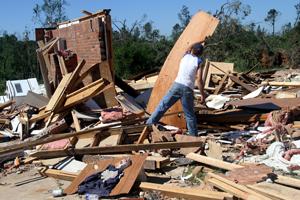Junior Halea Blair held her breath while she waited for a text from her older sister Chelsea Blair, class of ’08, hoping that she would be ok.
After the students at Samford University in Birmingham, Alabama were evacuated due to a tornado in the area, Halea tried to contact Chelsea because her family did not hear anything from her. To her relief, “she and her friends were not hurt and everyone is ok,” she said.
“They [Chelsea and other students at Samford University] had to stay in their basement at their school for an entire night. There was severe flooding there the day after. About 20 miles away from her was where the major damage was. Houses were knocked down and people have died. I’m so thankful that she is ok. Thankfully, she was not where there was major damage,” Blair said.
According to the Associated Press, 340 people have died due to a string of severe tornadoes that have ripped through six states, making it the “deadliest outbreak in nearly 40 years.” Damage was found across Alabama, Mississippi, Tennessee, Georgia, Virginia and Kentucky after the April 27 storms.
In addition, the National Weather Service stated that the speeds of tornadoes that have hit southern towns in the afflicted states range from wind speeds up to 200 mph. They also estimate that there were 266 tornadoes in the 24 hour period ending April 28.
According to The Wall Street Journal, one of the worst tornadoes that tore through Tuscaloosa and Birmingham, Alabama was an 80-mile-long, 1.5-mile-wide tornado that caused the death of about 65 people and injured at least a thousand others.
Alabama was hit the hardest with 249 deaths and “as many as a million people” without power. National Guard troops have been deployed to help the stricken states search for missing people. President Obama visited Alabama’s governor Robert Bentley “to approve his request for emergency federal assistance,” according to USA Today.
The Red Cross stepped into set up shelters in Tuscaloosa, and in other neighborhoods such as Tuscaloosa’s Alberta neighborhood, “a mix of city employees, church members, National Guard troops, and supermarket workers, and residents” built relief stations to help supply each other with basic necessities.
Greg Carbin, warning coordination meteorologist of the National Weather Service, told ABC News that “he could not predict whether more killer tornadoes were on their way.”
“May is usually the most active tornado month. Will it maintain the activity of April? We just cannot say,” Carbin told ABC News.
Grace Kim is a Managing Editor for “The Patriot” and jcpatriot.com.



